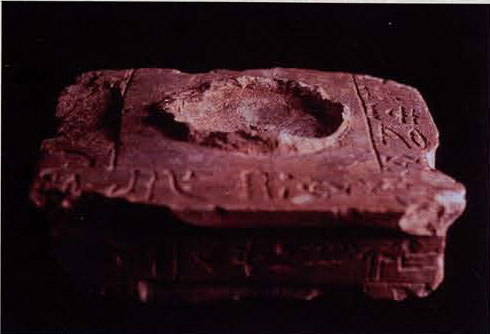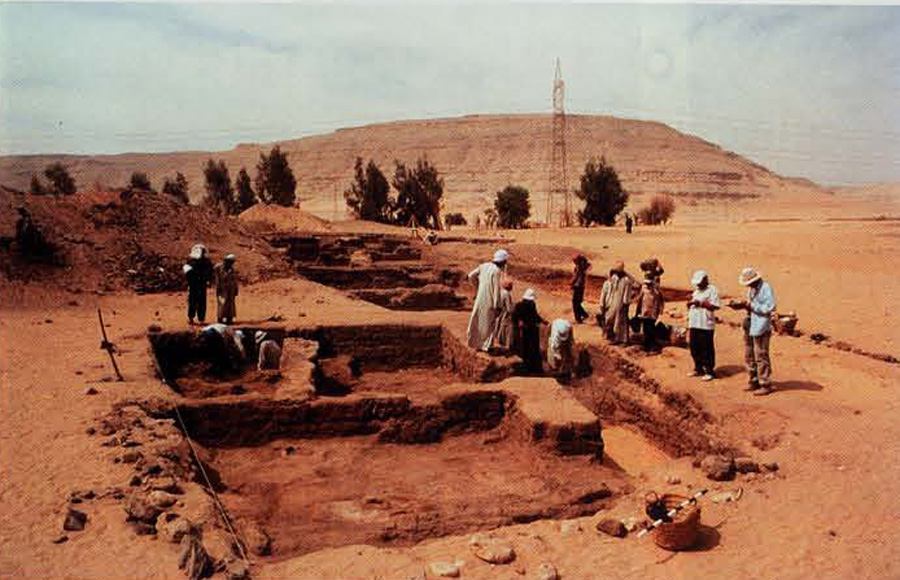
For 1000 miles, from the Mediterranean Sea south into Nubia, the Nile Valley is dense with the great buildings of three millennia of Pharaonic civilization. Egypt is famous for its ancient stone monuments: imposing tombs and temples dedicated to gods and kings. In contrast, early Egyptian towns and cities have been much less visible. Constructed predominantly of mud-brick and usually built on or near the rich Nile floodplain, Egyptian settlements of all sizes—from magnificent royal capitals to lowly farming villages—have almost invariably been buried beneath the sediments deposited by the Nile.
Working at Abydos in southern Egypt, we have recently discovered something which is far more rare and valuable to archaeology than a Pharaoh’s tomb: a well-preserved Egyptian town. Even more unusual is our discovery of the residence of the town’s most wealthy and powerful citizen: the mayor (the h3ty-‘ or “foremost-one” in ancient Egyptian). In fact, this is the only building from ancient Egypt positively identified as the residence of a town mayor. Since 1994, as part of the University of Pennsylvania—Yale University—New York University Expedition, we have been excavating at South Abydos, where there is a series of sites dating to Egypt’s Middle Kingdom (ca. 2050-170o BCE). Principal among these is a large royal mortuary complex built by the 12th Dynasty king Khakaure-Senwosret III (ca. 1878-1841 BCE).
Senwosret III’s complex includes a massive subterranean tomb and a temple where he was venerated through an offering cult maintained in perpetuity. In 1997 we discovered, preserved on clay seal impressions, the ancient name of Senwosret III’s cult complex: “Enduring-are-the-Places-of Khakaure-True-of-Voice-in-Abydos” (which the Egyptians—very logically—abbreviated to the simpler “Enduring-are-the-Places” or “Wahsut” in ancient Egyptian) masses of administrative seal impressions behind the building, some bearing the names of a series of mayors. This led me to propose that the building was actually the mayor’s residence. Other inscribed objects have since come to light that also bear the names of mayors.
This identification has been confirmed by our most recent season at Abydos, in the summer of 1999. More of the structure has been exposed, revealing a sprawling rectangular building measuring 52 by 80 meters. Walls and floors are of mudbrick, originally beautifully plastered throughout mostly in white but also using yellow, red, and other colors. Fragments of more complex decoration suggest that certain rooms were adorned with wall scenes. Important doorways had limestone thresholds and doors fitted with jambs of cedar wood. The building included secluded living quarters for the mayor himself arrayed around a spacious living room with a roof supported by four columns. Besides the colonnaded hall already mentioned, the building originally had a broad open courtyard at its center with a 45-meter-wide portico on one side supported by eight massive columns. There were also support areas for food preparation and storage, as well as large-volume granaries and storage units for flour. Grain, the functional currency of the ancient Egyptian economy, seems to have been controlled in great quantity by the mayor. Perhaps most fascinating is the image of daily life which is now emerging from the mayor’s residence. In certain contexts inside the building we find remains of personal possessions: fragments of cosmetic containers, mirrors and jewelry, children’s toys and games. Other parts of the building testify to administration (deposits of clay seal impressions). The building clearly served not only as the mayor’s personal abode but as his place of business—the administrative hub of “Endure- ing-are-the-Places.” We can reconstruct a building bustling with activity. Besides the permanent inhabitants (the mayor’s family, children, and servants), the building would have been filled on a daily basis with large numbers of officials, priests, and scribes as the mayor attended to the affairs of temple and town. The building’s granaries would have seen a continuous flow of men carrying sacks of grain and scribes documenting them. Carriers would have arrived regularly with water jars (brought on donkey-back from a nearby canal). Occasionally a messenger would have arrived from the vizier or king himself (we find abundant seal impressions from documents sent from the royal court).

In three seasons we have excavated approximately half of the mayor’s residence; in future seasons we will document the remaining parts of the building, which will allow us to reconstruct in great detail how it was used. It is a rare opportunity to gain insight into ancient Egyptian town life and understand how Egyptian society built and maintained such truly “enduring” monuments.
In order to ensure that his mortuary cult was truly “enduring,” Senwosret III mandated the establishment of a large town to house a veritable army of priests and officials, as well as their families site excavations in 1999 and dependents. The mayor was the highest ranking official. The town provided the infrastructure necessary to maintain an economic foundation, allowing Senwosret III’s cult to continue for eternity.
Although we knew of the existence of the town, we had not realized how large or well preserved it was. In 1994, following surface survey and mapping, we selected a promising locale for excavation—an area with abundant indications of high-standing architecture. There we exposed habitation rooms belonging to what was clearly a large, elite residential building. In 1997 the size of the building became clearer as remains came to light of a 35-meter-long hall with a colonnade composed of 14 columns. Due to the building’s large size, I briefly entertained the possibility that it might be a royal palace, but we then discovered masses of administrative seal impressions behind the building, some bearing the names of a series of mayors. This led me to propose that the building was actually the mayor’s residence. Other inscribed objects have since come to light that also bear the names of mayors.
This identification has been confirmed by our most recent season at Abydos, in the summer of 1999. More of the structure has been exposed, revealing a sprawling rectangular building measuring 52 by 80 meters. Walls and floors are of mud-brick, originally beautifully plastered throughout mostly in white but also using yellow, red, and other colors. Fragments of more complex decoration suggests that certain rooms were adorned with wall scenes.
Important doorways had limestone thresholds and doors fitted with jambs of cedar wood. The building included secluded living quarters for the Mayor himself arrayed around a spacious living room with a roof supported by four columns. Besides the colonaded hall already mentioned, the building originally had a broad open courtyard at it’s center with a 45-meter-wide portico on one side supported by eight massive columns. There wrer also supported areas for food preparation and storage, as well as large-volume granaries and storage units for flour. Grain, the functional currency of the ancient Egyptian economy, seems to have been controlled in great quantity by the mayor.
Perhaps most fascinating is the image of daily life which is now emerging from the mayor’s residence. In certain contexts inside the building we find remains of personal possessions: fragments of cosmetic containers, mirrors and jewelry, children’s toys and games. Other parts of the building testify to administration (deposits of clay seal impressions). The building clearly served not only as the mayor’s personal abode—the administrative hub of “Eduring-are-the-Places.” We can construct a building bustling with activity. Beside the permanent inhabitants (the mayors family, children, and servants), the building would have been filled on a daily basis with large numbers of officials, priests, and scribes as the mayor attended to the affairs of the temple and town. The buildings granaries would have seen a continuous flow of men carrying sacks of grain and scribes documenting them. Carriers would have arrived regularly with water jars (brought by donkey back from the nearby canal). Occasionally a messenger would have arrived from the vizier of king himself (we find abundant seal impressions from documents sent from the royal court).
In three seasons we have excavated approximately half of the mayor’s residence; in future seasons we will document the remaining parts of the building, which will allow us to reconstruct in great detail how it was used. It is a rare opportunity to gain insight into ancient Egyptian town life and understand how Egyptian society built and maintained such truly “enduring” monuments.
Josef Wegner
Assistant Professor of Asian and Middle Eastern Studies
Assistant Curator, Egyptian Section
